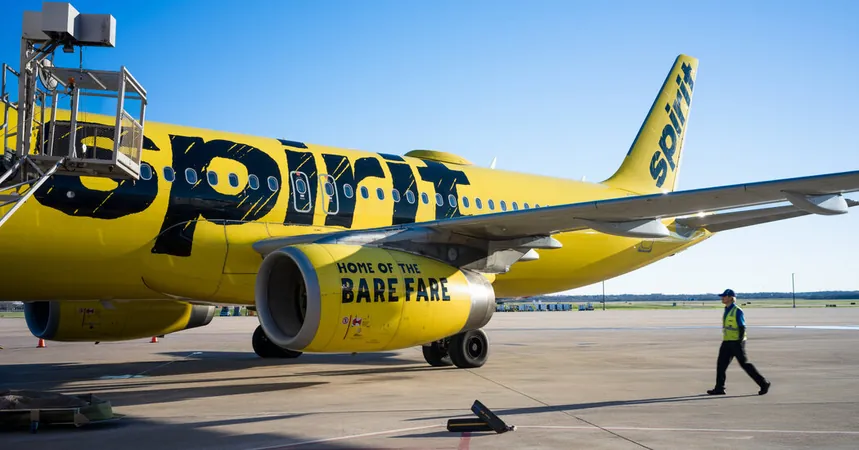
Spirit Airlines Files for Bankruptcy: What This Means for Travelers and the Airline Industry
2024-11-18
Author: Yan
Overview of Spirit Airlines' Bankruptcy Filing
In a shocking turn of events, Spirit Airlines, known for its no-frills approach to air travel, has filed for bankruptcy protection after a series of unfortunate setbacks, including a failed attempt to renegotiate its significant debt on Monday. The move marks a challenging chapter for an airline that hasn't turned a profit since 2019.
Filing Details and Financial Context
The bankruptcy filing, made under Chapter 11 in New York, comes after a federal judge blocked Spirit's planned merger with JetBlue Airways earlier this year, further complicating its financial recovery efforts in a post-pandemic travel environment marked by fierce competition and operational challenges. With total debts nearing $9 billion and between 25,000 to 50,000 creditors, Spirit is now working with bondholders to restructure its liabilities and secure operating funds while it navigates this process. The company anticipates exiting bankruptcy by the first quarter of next year and has reassured customers that they can continue to use their tickets, credits, and loyalty points as usual.
Leadership and Future Outlook
CEO Ted Christie expressed optimism about the airline's future, stating that the arrangements made represent a “strong vote of confidence in Spirit and our long-term plan.” Despite its struggles, Spirit has undeniably played a significant role in reshaping the airline industry. Its focus on ultra-low fares and bare-bones service has inspired many other carriers to adopt similar models, making budget travel more accessible but often at the cost of service quality.
The Evolution of Spirit Airlines
Initially starting as a trucking company in 1964 and evolving into a tour operator before launching flights in 1990, Spirit Airlines truly found its niche after being acquired by Indigo Partners in 2006. The leadership of the late Ben Baldanza emphasized cost efficiency, which drew both a loyal customer base and criticism alike, culminating in a business model that became the butt of countless jokes but also turned the airline into a staple of budget travel.
Market Position and Competition
According to Cirium, a data analytics firm, round-trip tickets with Spirit average $140, slightly more than Frontier Airlines and Allegiant Airlines, its main budget competitors. However, as the summer of 2023 recorded record air travel numbers, budget carriers like Spirit struggled with rampant market saturation. Larger airlines have recently moved to introduce basic economy options, creating even more competition for low-cost carriers like Spirit.
Operational Challenges
Spirit's operational issues extend beyond competitive pressures; engine defects from Pratt & Whitney have grounded roughly 10% of its fleet, leading to further instability as the airline begins 2024 expecting to have up to 67 planes out of service. Compounding this, Spirit has delayed aircraft deliveries and resorted to furloughs and plane sales to cope with financial strain, noting that a significant portion of its fleet is leased.
Innovations in Response to Market Conditions
In response to the economic landscape, Spirit attempted to innovate by introducing premium fare bundles earlier this summer, offering enhanced services—a notable pivot for an airline that has long marketed itself as the cheapest option. These fare changes suggest Spirit may be trying to adapt to a shifting market where customers are increasingly willing to pay for added comforts.
The Future of Spirit Airlines and Budget Travel
As the airline industry witnesses Spirit's attempts at rejuvenation amid great challenge, its future remains uncertain, but history shows that airlines often emerge stronger from Chapter 11, armed with more manageable debt and refined strategies. Indeed, this could be a turning point not just for Spirit Airlines, but also for the landscape of budget travel as competitors feel the pressure to innovate in response.




 Brasil (PT)
Brasil (PT)
 Canada (EN)
Canada (EN)
 Chile (ES)
Chile (ES)
 España (ES)
España (ES)
 France (FR)
France (FR)
 Hong Kong (EN)
Hong Kong (EN)
 Italia (IT)
Italia (IT)
 日本 (JA)
日本 (JA)
 Magyarország (HU)
Magyarország (HU)
 Norge (NO)
Norge (NO)
 Polska (PL)
Polska (PL)
 Schweiz (DE)
Schweiz (DE)
 Singapore (EN)
Singapore (EN)
 Sverige (SV)
Sverige (SV)
 Suomi (FI)
Suomi (FI)
 Türkiye (TR)
Türkiye (TR)